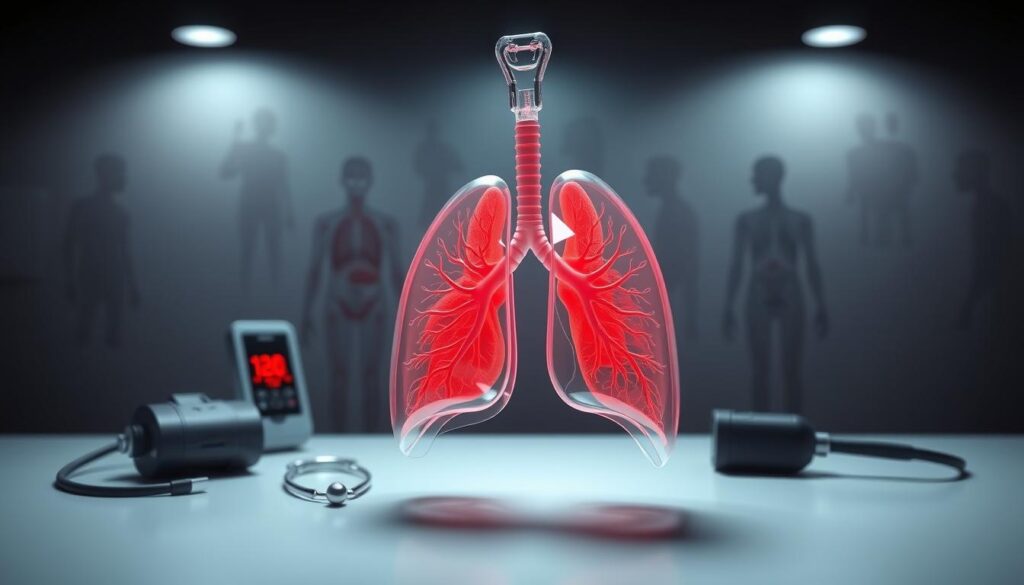Did you know that the average person takes 20,000 breaths a day? This natural process is more than just a bodily function—it’s a cornerstone of your overall health. Research shows that altering your breathing can have a profound impact on both your physical and mental well-being1.
When you inhale, your diaphragm moves down, increasing heart volume and slowing blood flow. This mechanical change signals your brain to speed up your heart rate2. Conversely, exhaling decreases heart volume, leading to faster blood flow2. This two-way communication between your brain and body is crucial for maintaining balance in your internal system.
Mindful breathing isn’t just about relaxation; it’s a powerful tool for self-care. Diaphragmatic breathing, for instance, has been shown to benefit those with chronic obstructive pulmonary disease (COPD) and heart conditions1. By focusing on each breath, you’re nurturing your heart and supporting your brain health.
Key Takeaways
- Mindful breathing impacts your brain function and physical vitality.
- Proper breath maintenance supports your heart and internal system.
- Diaphragmatic breathing can aid relaxation and improve health conditions.
- Each breath sends life-giving oxygen to your brain and heart.
- Mindful breathing is a natural self-care practice for overall well-being.
Understanding the Link Between Breath and Brain
Every person’s breathing pattern plays a crucial role in their overall health. Research shows that altering your breathing rate can significantly influence your autonomic nervous system, which manages your body’s automatic functions like heart rate and digestion3.
Breathing and Autonomic Regulation
When you practice slow breathing, it activates the parasympathetic system, which helps reduce stress and anxiety3. This system promotes relaxation and lowers your heart rate, creating a calming effect on your body. On the other hand, rapid breathing can trigger the sympathetic nervous system, increasing heart rate and alertness3.
Brain Health and Oxygen Flow
Oxygen is essential for brain health. When you breathe deeply, more oxygen reaches your brain, enhancing cognitive function and focus4. Poor breathing habits can lead to inadequate oxygen supply, potentially affecting your mental clarity and energy levels.
Efficient breathing patterns are vital for maintaining healthy lungs and brain function. By optimizing how you breathe, you can improve your overall vitality and reduce the risk of lung disease4.
The Breath of Life: Why Lung Care is Self-Care for Your Brain
Your breathing rate has a profound impact on your overall well-being. Scientific studies reveal that slowing your breathing can enhance heart rate variability, boosting cardiovascular health and benefiting brain function5.
By adjusting your breathing, you empower your body to heal and increase energy levels. Each controlled exhale supports mental and physical performance, showcasing the power of mindful breathing6.
Even minor changes in breathing rate can significantly affect your physiological balance. This highlights the life-affirming power of breath in enhancing your quality of life7.
Research underscores the strong link between breathing and life quality. Mindful breathing practices, such as diaphragmatic breathing, can improve oxygen exchange and strengthen your diaphragm5.
| Benefit | Effect | Impact |
|---|---|---|
| Slower Breathing Rate | Improves Heart Rate Variability | Enhances Cardiovascular Health |
| Controlled Exhalation | Supports Mental Clarity | Boosts Physical Performance |
| Mindful Breathing Practices | Increases Oxygen Flow | Strengthens Brain Function |
Exploring the Science of Slow Breathing
Slow breathing techniques have gained attention for their profound effects on both respiratory and brain health. Research shows that practices like paced breathing can synchronize heart and brain activity, leading to improved relaxation and physiological efficiency8.
Paced Breathing Techniques Explained
Paced breathing involves consciously slowing down your breaths, typically to 4–10 breaths per minute8. This method activates the parasympathetic nervous system, promoting relaxation and reducing stress8.
- Slower breathing enhances heart rate variability, boosting cardiovascular health8.
- Controlled exhalation supports mental clarity and physical performance9.
- Mindful breathing practices increase oxygen flow, strengthening brain function10.
Physiological Mechanisms Behind Breath Control
When you adopt slow breathing, your heart rate varies more, which is linked to better cardiovascular health8. This increased heart rate variability is a sign of a resilient cardiovascular system.
Deep breathing engages more muscles, improving lung capacity and overall respiratory health9. This not only benefits the lungs but also enhances brain activity by ensuring a steady oxygen supply.
By understanding and practicing slow breathing, you can harness its power to improve both your respiratory and brain health, leading to a better quality of life10.
Mastering Diaphragmatic and Alternate Nostril Breathing
Discover how to enhance your breathing techniques for improved health. Diaphragmatic breathing and alternate nostril techniques offer unique benefits, from boosting lung capacity to sharpening focus.
Steps for Effective Diaphragmatic Breathing
Start by sitting comfortably with your back straight. Place one hand on your belly and the other on your chest. Inhale deeply through your nose, allowing your belly to rise while your chest remains still. Exhale slowly through pursed lips, feeling your belly drop. Practice this 5-10 times daily to improve lung function and reduce stress11.
Benefits of Alternate Nostril Technique
This technique involves closing one nostril and breathing through the other. A 2018 study found that men practicing alternate nostril breathing for 30 minutes daily experienced lower perceived stress levels after 3 months12. It also enhances attention and motor learning, contributing to improved cognitive performance and stress reduction.

By committing to these practices yearly, you support your body’s function and well-being. Proper breathing plays a crucial role in regulating internal functions, ensuring optimal oxygen intake and physical performance.
- Diaphragmatic breathing expands your belly for better lung function.
- Alternate nostril technique balances cognitive functions and reduces stress.
- Both practices maximize oxygen intake, benefiting brain and body.
Breathing, Heart Health, and Respiratory Efficiency
Discover how your breathing patterns can significantly influence your heart health and overall bodily efficiency. By mastering specific techniques, you can unlock profound benefits for your cardiovascular system and respiratory function.
Understanding Heart Rate Variability
Heart rate variability (HRV) measures the variation in time between each heartbeat. Higher HRV is linked to better cardiovascular health and stress resilience. Research shows that synchronizing your breathing with your heart rate can improve HRV, enhancing your ability to manage stress and maintain heart health13.
- Explore how improved breathing techniques can lead to significant changes in heart health and overall bodily efficiency.
- Learn how controlled breathing triggers beneficial changes in heart rate variability.
- Discover practical ways to implement breathing changes that enhance respiratory efficiency and heart function.
- Connect scientific evidence with everyday practices that lead to dramatic improvements in cardiovascular well-being.
- Embrace breathing practices as a transformative change for optimizing both your body and heart.
| Benefit | Effect | Impact |
|---|---|---|
| Controlled Breathing | Improves Heart Rate Variability | Enhances Cardiovascular Health |
| Slow Breathing | Reduces Stress and Anxiety | Supports Overall Well-being |
| Diaphragmatic Breathing | Increases Oxygen Flow | Boosts Respiratory Efficiency |
By implementing these breathing practices, you can create a transformative change in your body and heart health, leading to a more resilient and efficient cardiovascular system.
Recognizing the Signs of Poor Lung Health
Identifying early signs of declining lung health is crucial for maintaining your well-being. Paying attention to changes in your breathing patterns and environmental factors can help you take proactive steps toward better respiratory health.
Early Warning Signs to Watch For
One of the first indicators of poor lung health is a persistent cough that lasts more than a few weeks. This could signal an underlying issue, especially if accompanied by shortness of breath during routine activities14. Monitoring your breath per minute can help detect irregularities early, as changes in breathing rate often correlate with lung function changes.
Impact of Air Quality and Environmental Pollutants
The air you breathe, both indoors and outdoors, significantly affects your respiratory health. Pollutants like dust, mold, and household chemicals can irritate your lungs, exacerbating existing conditions14. Improving indoor air quality through HEPA filters and radon testing can mitigate these risks.
- Watch for persistent coughing and shortness of breath as early warning signs.
- Monitor your breath per minute to detect potential issues early.
- Address environmental factors like air quality to protect your lungs.
- Implement practices that enhance indoor air quality for better health.

Everyday Practices to Improve Your Breathing Technique
Enhancing your breathing technique can have a transformative impact on your health and well-being. Simple exercises, backed by science, can improve lung capacity and reduce the risk of lung disease. By incorporating these practices into your daily routine, you can enhance respiratory quality and overall vitality.
Simple Exercises to Enhance Lung Capacity
Start with diaphragmatic breathing. Sit comfortably, place one hand on your belly and the other on your chest. Inhale deeply through your nose, allowing your belly to rise while your chest remains still. Exhale slowly through pursed lips, feeling your belly drop. Practice this 5-10 times daily to improve lung function and reduce stress15.
Another effective exercise is pursed-lip breathing. Inhale through your nose for 2-3 seconds, then exhale slowly through pursed lips for 4-6 seconds. This technique helps slow down breathing, improving oxygen exchange and reducing shortness of breath16.
| Exercise | Benefit | Impact |
|---|---|---|
| Diaphragmatic Breathing | Strengthens Diaphragm | Improves Lung Capacity |
| Pursed-Lip Breathing | Slows Breathing Rate | Enhances Oxygen Exchange |
| 4-7-8 Technique | Calms Nervous System | Improves Sleep Quality |
Consistent practice of these exercises can lead to noticeable improvements in respiratory quality. By dedicating just a few minutes each day, you can enhance your lung health and overall well-being.
Addressing Lung Diseases and Preventative Care
Lifestyle adaptations play a crucial role in maintaining healthy lungs and preventing diseases. By making informed choices, you can significantly reduce your risk of developing conditions like chronic obstructive pulmonary disease (COPD) and enhance your overall pulmonary health17.
Lifestyle Changes That Support Healthy Lungs
A healthy diet and regular exercise are foundational to lung health. Eating nutrient-rich foods helps strengthen your respiratory system, while physical activity improves oxygen flow18. Additionally, avoiding environmental pollutants and quitting smoking can drastically reduce lung disease risks17.
Society plays a role in lung health through awareness campaigns and policy changes. Progress in preventative care has led to better resources for early detection and treatment17. Understanding how societal and environmental factors impact your lungs empowers you to make proactive choices.
Your work environment is another critical factor. Minimizing exposure to harmful irritants at work can prevent long-term lung damage17. Employers and employees must collaborate to create safer workplaces, reducing the risk of respiratory issues.
Customizing your diet and exercise routine can reinforce lung strength. Regular check-ups are essential for early detection of potential issues17. By prioritizing these aspects, you can fortify your respiratory system against disease.
- Adopt a balanced diet rich in antioxidants to support lung function.
- Engage in physical activities that promote deep breathing and oxygen intake.
- Advocate for cleaner air quality in your community to reduce pollution exposure.
Everyday choices have a profound impact on lung health. By making informed decisions, you contribute to a healthier society and support progress in preventative care. Remember, your work towards a healthier lifestyle is an investment in your future well-being.
Integrating Breathing Practices Into Your Wellness Routine
Creating a consistent breathing practice can transform your wellness journey. By tailoring your approach to fit your lifestyle, you can experience lasting benefits for both body and mind.
Creating a Personalized Breathing Plan
A well-structured plan begins with understanding your health goals and daily schedule. Start by allocating just 5-10 minutes each day for focused breathing exercises19. This small time investment can yield significant long-term benefits, such as improved emotional regulation and increased oxygen flow20.
Combine modern medicine insights with traditional techniques. For example, the 4-7-8 method—inhaling for 4 seconds, holding for 7, and exhaling for 8—has been shown to reduce anxiety and improve heart rate variability21. Such practices not only enhance respiratory efficiency but also support mental clarity and overall well-being.
Regular practice is key. Over time, you may notice improvements in how you handle stress and your ability to stay focused. Adjust your techniques as needed to ensure they remain effective and enjoyable.
Scientific Evidence and Research-Driven Insights
Recent studies highlight the profound impact of controlled breathing on both physical and mental health. Peer-reviewed research reveals how specific techniques can influence heart rate variability, brain activity, and overall well-being22.
Key Findings from Recent Studies
A study published in Nature Neuroscience identified a brain circuit regulating voluntary breathing, linking the anterior cingulate cortex to the pons and medulla22. This discovery shows how activation of this circuit calms mice, slowing their breathing rates22.
Research from a systematic review of 15 articles found that slow breathing, defined as 10 breaths per minute or less, improves heart rate variability and autonomic nervous system function23. For instance, paced breathing at 6 breaths per minute increased SDNN and HF power, enhancing cardiovascular health23.
These findings translate to real-world benefits. Patients with chronic respiratory diseases, which caused 4 million deaths globally in 201924, can experience improved outcomes through regular breathing exercises. This approach not only aids in managing symptoms but also addresses the economic burden, with projected costs reaching $4.3 trillion by 205024.
By understanding and applying these research insights, you can enhance your personal health experience. The reproducibility of these studies offers confidence in their benefits, motivating consistent breathing practices for better heart and brain function.
Conclusion
Embracing mindful breathing is more than just a habit—it’s a vital step in your journey toward better health. By prioritizing your respiratory well-being, you’re not only supporting your heart and brain but also addressing a core concern for your overall vitality25.
Your path to improved health is an ongoing journey. Integrating conscious breathing practices into your daily routine can lead to significant changes, helping you fight against poor respiratory health and enhancing your mental clarity26.
The scientific evidence is clear: consistent breathing exercises can transform your well-being. From reducing stress to improving heart rate variability, these practices offer tangible benefits that elevate your wellness routine25. Remember, every breath is a step in the fight against respiratory challenges and a commitment to renewed vitality.
FAQ
How does lung health affect the brain?
What are the early signs of poor lung health?
How can I improve my lung capacity through exercise?
What role does air quality play in lung health?
How does breathing technique impact the heart?
What are the benefits of slow breathing exercises?
How can I check my breathing rate accurately?
What are the first steps if diagnosed with a lung disease?
How does pollution affect lungs and overall health?
Can lifestyle changes help prevent lung diseases?
Source Links
- 10 Breathing Techniques for Stress Relief – https://www.healthline.com/health/breathing-exercise
- How to Optimize Your Brain-Body Function & Health – https://www.hubermanlab.com/episode/how-to-optimize-your-brain-body-function-and-health
- Can the way we breathe affect brain health? | Cognitive Vitality – https://www.alzdiscovery.org/cognitive-vitality/blog/can-the-way-we-breathe-affect-brain-health
- It’s not just inspiration – careful breathing can help your health – https://www.heart.org/en/news/2023/07/07/its-not-just-inspiration-careful-breathing-can-help-your-health
- How Conscious Breathing Can Help Relieve Anxiety and Stress – https://www.healthline.com/health/mind-body/conscious-breathing
- How Breathing Can Help Reduce Stress – https://www.mentalhealthfirstaid.org/2021/07/how-breathing-can-help-reduce-stress/
- Top tips for keeping your lungs healthy – https://www.nuvancehealth.org/health-tips-and-news/top-tips-for-keeping-your-lungs-healthy
- The Breath of Life: Exploring the Wonders of Slow Breathing – The Bind – https://thebind-selfcare.com/the-breath-of-life-exploring-the-wonders-of-slow-breathing/
- Why is Slow, Deep Breathing Good for Your Health? – https://kids.frontiersin.org/articles/10.3389/frym.2024.795930
- The Power of Breath: The Surprising Benefits of Conscious Breathing – https://dhwblog.dukehealth.org/the-power-of-breath-the-surprising-benefits-of-conscious-breathing/
- Mastering the Art of Conscious Breathing – https://todayspractitioner.com/mind-body-medicine/mastering-the-art-of-conscious-breathing/
- Alternate Nostril Breathing: Benefits, How To, and More – https://www.healthline.com/health/alternate-nostril-breathing
- Breathing Practices for Stress and Anxiety Reduction: Conceptual Framework of Implementation Guidelines Based on a Systematic Review of the Published Literature – https://pmc.ncbi.nlm.nih.gov/articles/PMC10741869/
- Breathe Easy: Expert Tips for Maintaining Lung Health – https://www.fau.edu/medicine/news/lung-health-tips/
- Breathing Techniques for Stress Relief – https://www.webmd.com/balance/stress-management/stress-relief-breathing-techniques
- Breathwork for Beginners: What To Know and How To Get Started – https://health.clevelandclinic.org/breathwork
- Tips to Keep Your Lungs Healthy – https://www.lung.org/lung-health-diseases/wellness/protecting-your-lungs
- Self management for patients with chronic obstructive pulmonary disease – https://pmc.ncbi.nlm.nih.gov/articles/PMC7004246/
- Mindfulness and Stress Reduction Techniques: Integrating Wellness Into Daily Life – Wooster Community Hospital – https://www.woosterhospital.org/mindfulness-and-stress-reduction-techniques-integrating-wellness-into-daily-life/
- A Beginner’s Guide to Breath Work Practices – https://www.everydayhealth.com/alternative-health/living-with/ways-practice-breath-focused-meditation/
- 4-7-8 Breathing: How It Works, How to Do It, and More – https://www.healthline.com/health/4-7-8-breathing
- Scientists discover brain circuit for voluntary breathing control – https://www.news-medical.net/news/20241120/Scientists-discover-brain-circuit-for-voluntary-breathing-control.aspx
- Frontiers | How Breath-Control Can Change Your Life: A Systematic Review on Psycho-Physiological Correlates of Slow Breathing – https://www.frontiersin.org/journals/human-neuroscience/articles/10.3389/fnhum.2018.00353/full
- Lung health for life: improving care for people with chronic respiratory diseases – https://www.healthpolicypartnership.com/app/uploads/Lung-health-for-life-improving-care-for-people-with-chronic-respiratory-diseases.pdf
- Breathlessness and the brain: the role of expectation – https://pmc.ncbi.nlm.nih.gov/articles/PMC6686955/
- Effect of breathwork on stress and mental health: A meta-analysis of randomised-controlled trials – Scientific Reports – https://www.nature.com/articles/s41598-022-27247-y




